Before we begin the review, I would like to extend my gratitude towards Happy Hen Toys for sending this figure along as a review sample. Check out their large selection of animal and dinosaur figures by clicking the banner below.
Right whales of the genus Eubalaena are large, robust baleen whales that were heavily hunted by whalers for their high blubber content (up to 40% of their body weight). Their preference for coastal habitats, skim-surface feeding habits, docile and slow nature, and tendency to float upon death all made them easy to hunt. Indeed, they were the “right” whale to hunt, which is how they got their common name. Three species of right whale have been described, the North Atlantic (E. glacialis), North Pacific (E. japonica), and southern right whale (E. australis). The three species are nearly identical and can only reliably be identified through genetic testing or based on the location where they’re found. The North Atlantic right whale is critically endangered, with less than 400 individuals documented, it’s one of the most endangered mammals in the world. The North Pacific right whale is classified as endangered while the southern right whale is listed as least concern.
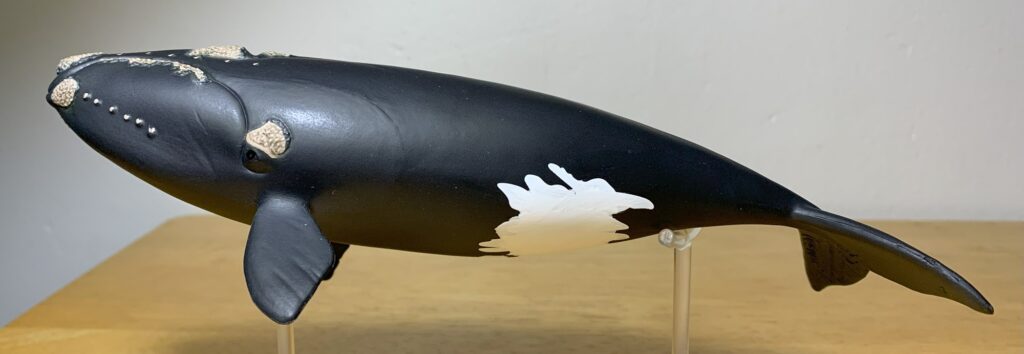
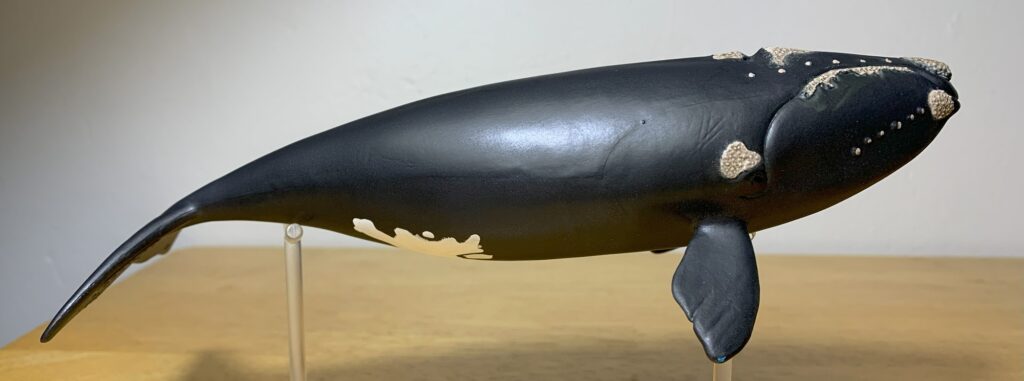
It’s rare that companies market their right whale figures at the species level but in 2025 Schleich released a North Atlantic right whale, a long overdue replacement for their previous right whale model, which was retired in 2009. I already have the superb Safari Ltd. right whale, but no whale collection would be complete without at least 3 right whale figures. Or at least, that’s the excuse I use to justify buying another model of my favorite baleen whale species. My Safari figure will henceforth be a North Pacific right whale.
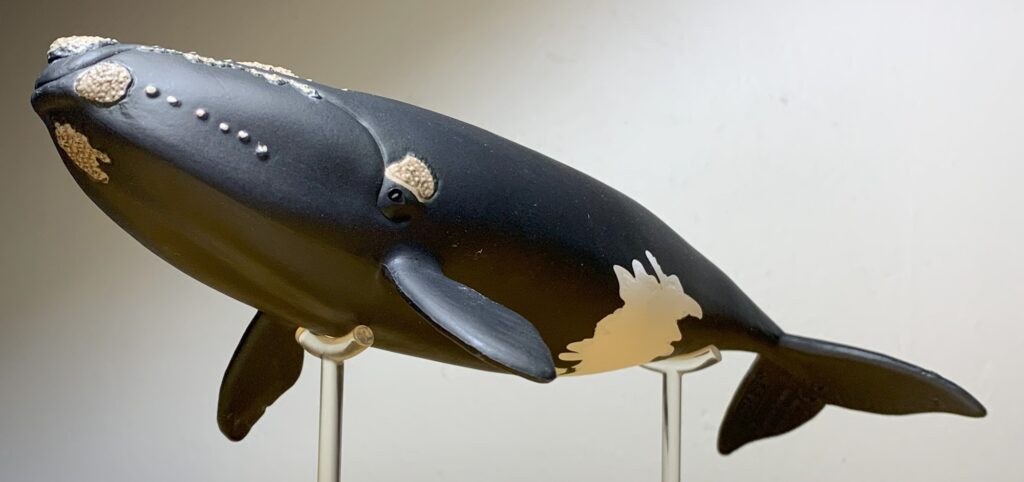
My fondness for the Balaenidae family (right and bowhead whales) is mostly due to their distinctive and impressive appearance but it’s also because there is a right whale skeleton on display at one of my favorite museums, the Museum of the Earth, in Ithaca, New York. Known as right whale #2030 this 44’ female died via fishing gear entanglement. Her entire skeleton is prominently displayed in such a way that you can even see her through the museum’s windows while driving past the building. I would see her almost daily during commutes to and from work or whilst traveling to Ithaca. I also volunteered at the museum for a time, so right whale #2030 has a lot of importance to me. I spent a lot of time just staring at that whale skeleton.
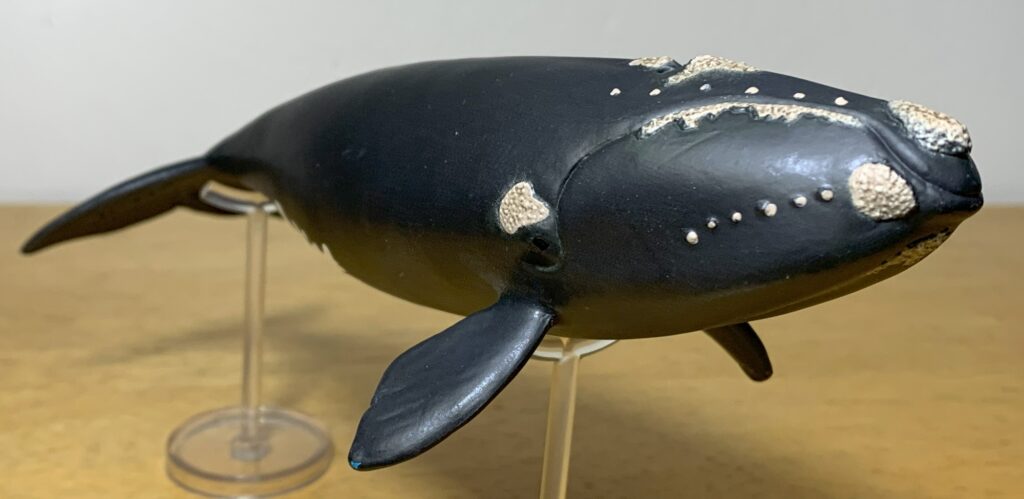
The North Atlantic right whale reaches an average length of 52’ (15 meters) but the longest recorded specimen was 56’ (17 meters). Males are 3-5’ feet shorter on average than females. The Schleich figure measures 8” (20.32 cm) long, from the snout to the notch between its flukes. This puts it at 1/78 in scale if scaled down from a length of 52’ and 1/84 if scaled down from a length of 56’. The figure is presented in a static pose, resting on its flippers and tail.
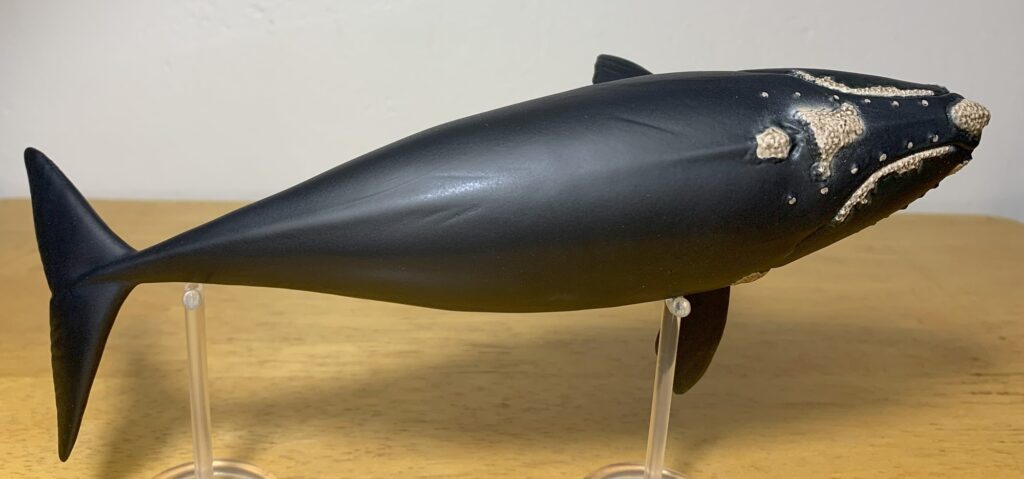
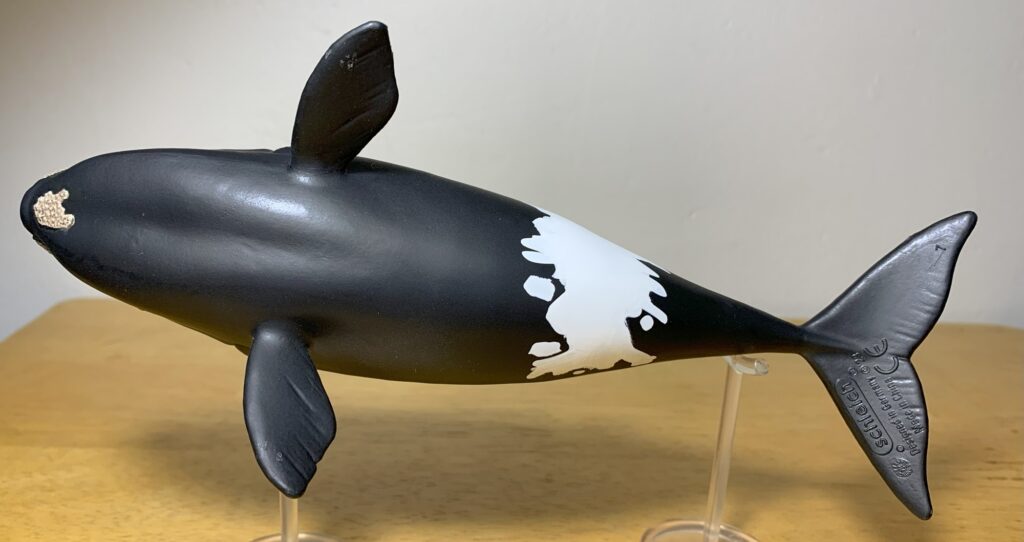
The figure nicely illustrates the large head and robust build of right whales. The mouthline is strongly arched and patches of rough skin, known as callosities, are sculpted about the head, and the blowholes are sculpted in a V shape. The flippers are short and broad, and the flukes are wide and triangular. There is no dorsal fin, which helps in identifying members of Balaenidae while at sea. There is no sculpted anus or umbilicus.
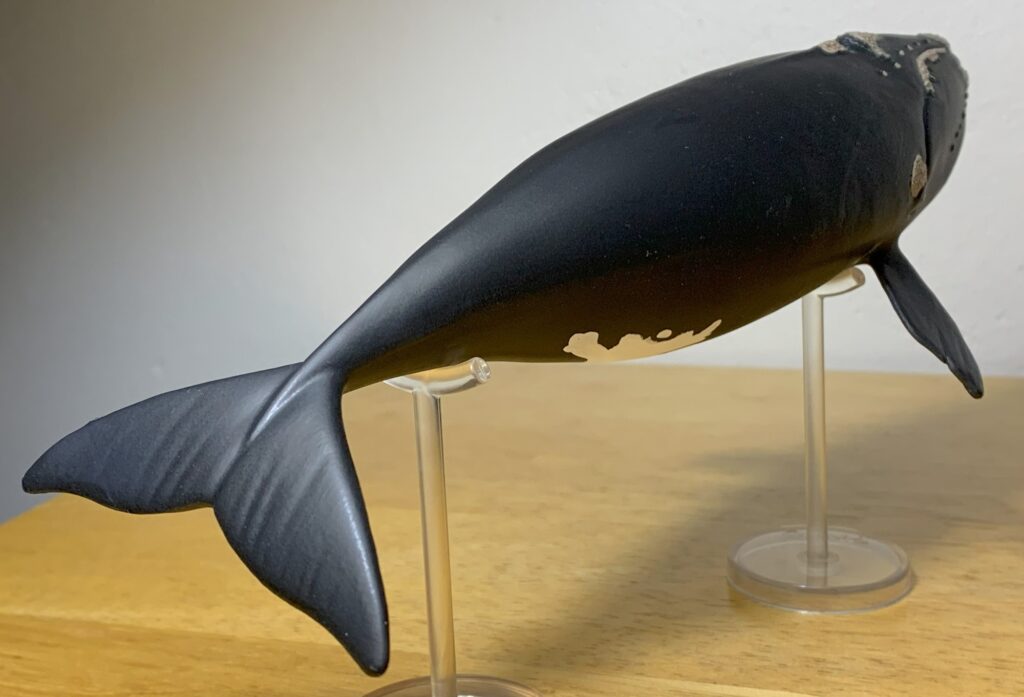
As for fine details, there’s a faint indentation between the mandibles, and faint grooves along the edges of the flippers and flukes. The callosities are sculpted on the end of the rostrum, on the lower lips and chin, above the eyes, and in front of and behind the blowhole. They are well rendered with a bumpy texture. The function of the callosities is a mystery, but each whale has its own unique arrangement of callosities that assist researchers with identifying individual whales. The callosities are also the habitat of various species of whale lice (cyamids). These small crustaceans feed on the whale but do not harm their host.
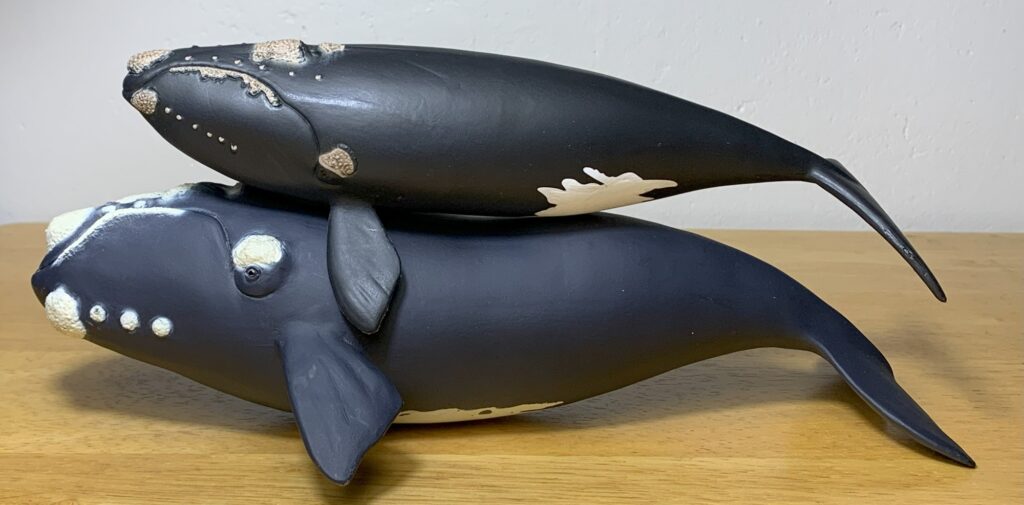
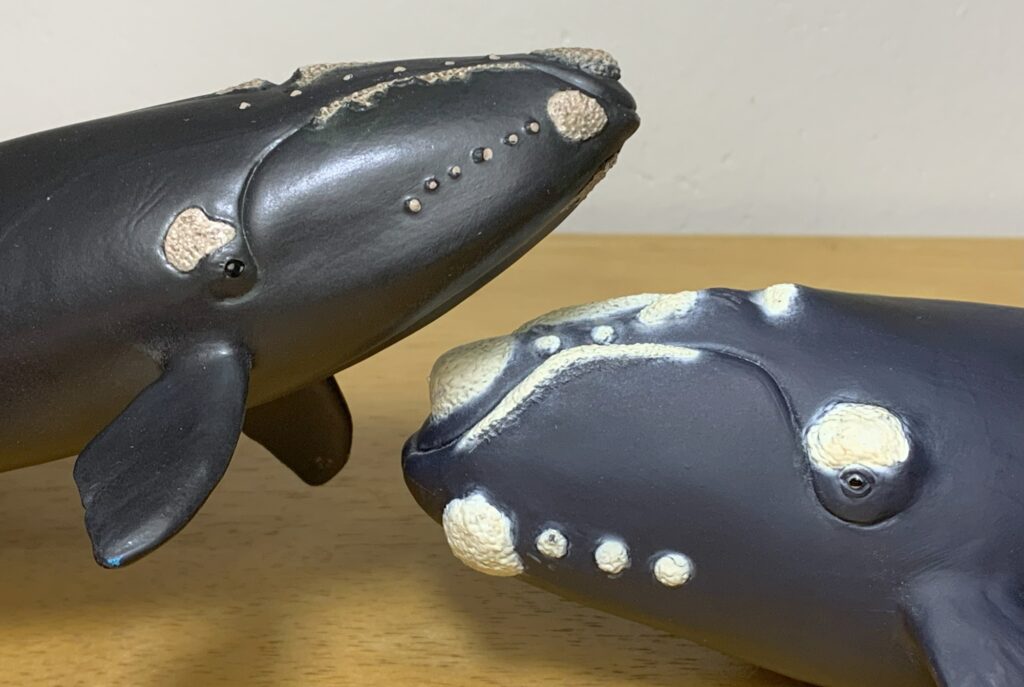
Large infestations of cyamids make the callosities appear white. On this figure they’re brown, so I guess this whale doesn’t harbor a lot of cyamids. Aside from the brown callosities and a white patch on the underside the figure is entirely black, with the eyes having a glossy finish on them. The paint application over the callosities is mostly decent but you’ll notice it’s a bit askew in some places, which can be seen on the picture below.
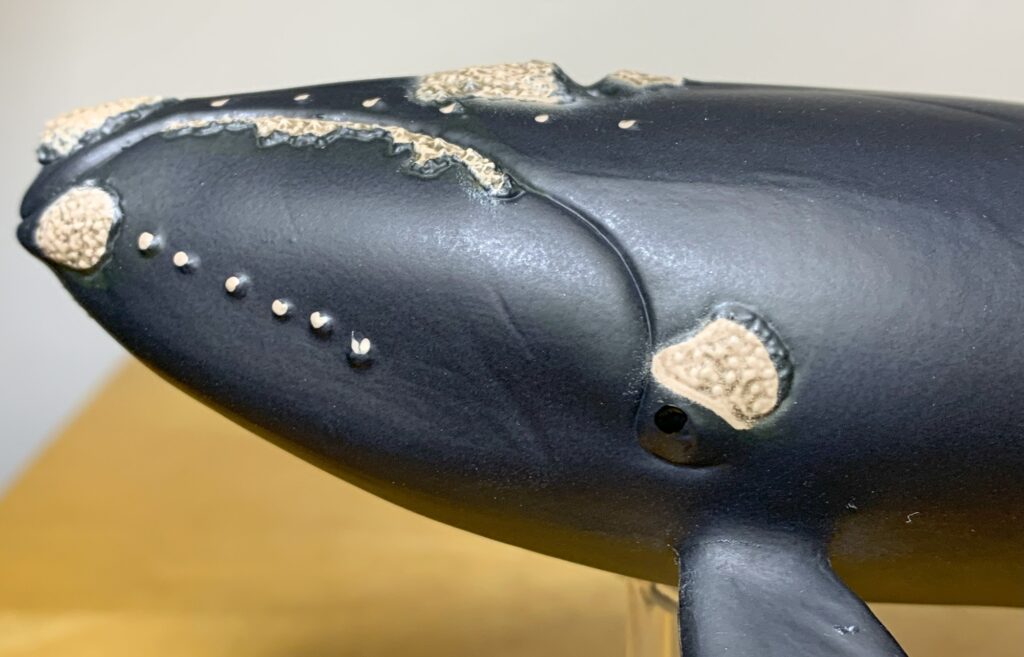
Decent right whale figures of various scales exist from Safari, Papo, and CollectA and they’re all currently in production. What makes this one unique is that it’s actually marketed as a specific right whale species while the other ones I mentioned are not. It doesn’t matter too much but pedants might appreciate it. Either way, if you’re going to collect cetaceans you’ll need at least three right whales and this one is a suitable choice. Highly recommended! You can purchase this figure over at Happy Hen Toys by clicking on the banner below.
Disclaimer: links to Ebay and Amazon on the AnimalToyBlog are affiliate links, so we make a small commission if you use them. Thanks for supporting us!





This is an impressive figure! I would get it, but I already have Safari’s. And yes, you gave an example of how Safari’s could work for a different species, but I have already databased it as a North Atlantic. Besides, given the space whale figures take up, I am not in a hurry for a new cetacean at the moment LOL. So, Safari will remain my sole right whale, as a North Atlantic.
But yes, great figure and review of it!
Well, as you can see from the picture, you could stack it on Safari’s. And Papo’s might be small enough to stack on top of them both!
I love this figure.
Although not quite as nice as the Collecta figure, it corrects all the anatomical problems of the Safari version.
Nice review,
In French, like in many other languages (except for German where it’s known as “smooth whale” or “North Caper”) this whale is called “baleine franche boréale” (northern right whale), but also sometimes nicknamed “baleine des Basques” (whale of the Basques).
The Basques, native to the coastal and mountainous areas between Spain and France, were undoubtedly the first whale hunters in Europe, starting to hunt whales in the Bay of Biscay in early medieval times. The northern right whale was a fat and slow-swimmer, and didn’t sink when it was killed. Thus it was the “right whale to kill” and their primary target But the gray whale, which was once also thriving in the Northern Atlantic, was also an easy prey.
The Basques recognized about eight species of whales, the northern right whale was known as “sarda” (schooling whale) because the whales could be found together in pods.
They have surely contributed to the extinction of the gray whale in the Atlantic sometime between the 16th and the 18th Century.
As for the northern right whale, it had already disappeared from the Bay of Biscay in the 12th Century. The Basques had to sail further away to hunt they down. They were seen in Iceland as early as the beginning of the 14th Century, and even reached the Grand Bank around 1530, discovering Canada before the French.
They had peaceful trade relations with the indigenous population, they went as far as to create a “Basque-Algonquin” pidgin in order to communicate more easily.
Unfortunately, the Basques, who later taught the English and Dutch whalers how to catch the whales, drove the northern right whale on the verge of extinction. Perhaps they are already gone forever on the European side of the Atlantic, and only a few handfuls survive on the American side.
Nevertheless, the northern right whale is still very important for my town of Biarritz, in the French Basque country. It’s still present in the city’s coat of arms.
You can still see the “atalayas”, the places where the whale-spotters played the drums or made a huge fire to warn the hunters that whales were in sight.
So that they could go for them on their row boats.
This is an interesting figure. I already own Collecta’s southern right whale, now I know I will also acquire this one, no matter its scale.